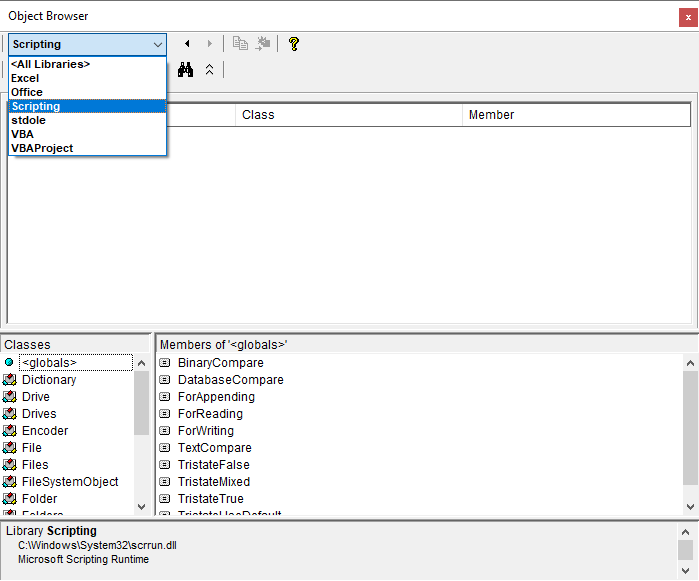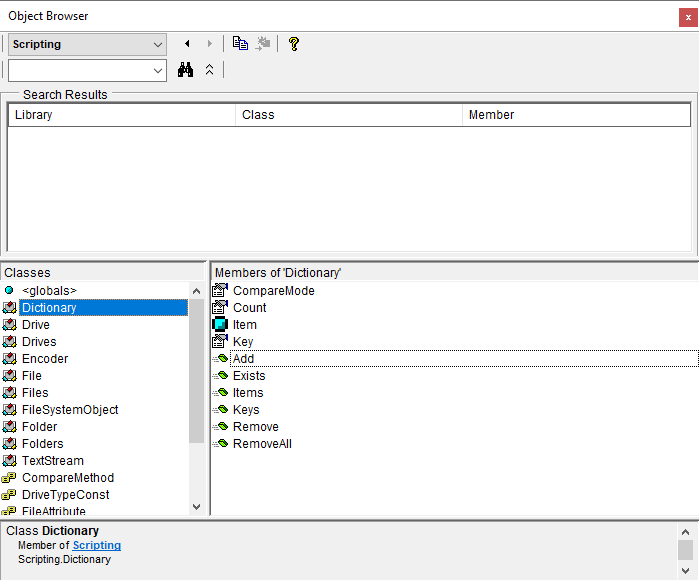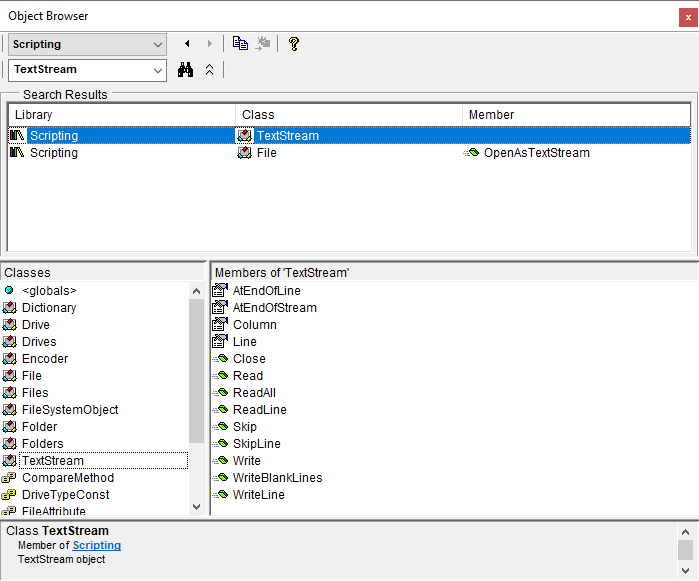Время на прочтение
7 мин
Количество просмотров 312K
Приветствую всех.
В этом посте я расскажу, что такое VBA и как с ним работать в Microsoft Excel 2007/2010 (для более старых версий изменяется лишь интерфейс — код, скорее всего, будет таким же) для автоматизации различной рутины.

VBA (Visual Basic for Applications) — это упрощенная версия Visual Basic, встроенная в множество продуктов линейки Microsoft Office. Она позволяет писать программы прямо в файле конкретного документа. Вам не требуется устанавливать различные IDE — всё, включая отладчик, уже есть в Excel.
Еще при помощи Visual Studio Tools for Office можно писать макросы на C# и также встраивать их. Спасибо, FireStorm.
Сразу скажу — писать на других языках (C++/Delphi/PHP) также возможно, но требуется научится читать, изменять и писать файлы офиса — встраивать в документы не получится. А интерфейсы Microsoft работают через COM. Чтобы вы поняли весь ужас, вот Hello World с использованием COM.
Поэтому, увы, будем учить Visual Basic.
Чуть-чуть подготовки и постановка задачи
Итак, поехали. Открываем Excel.
Для начала давайте добавим в Ribbon панель «Разработчик». В ней находятся кнопки, текстовые поля и пр. элементы для конструирования форм.
Появилась вкладка.
Теперь давайте подумаем, на каком примере мы будем изучать VBA. Недавно мне потребовалось красиво оформить прайс-лист, выглядевший, как таблица. Идём в гугл, набираем «прайс-лист» и качаем любой, который оформлен примерно так (не сочтите за рекламу, пожалуйста):
То есть требуется, чтобы было как минимум две группы, по которым можно объединить товары (в нашем случае это будут Тип и Производитель — в таком порядке). Для того, чтобы предложенный мною алгоритм работал корректно, отсортируйте товары так, чтобы товары из одной группы стояли подряд (сначала по Типу, потом по Производителю).
Результат, которого хотим добиться, выглядит примерно так:
Разумеется, если смотреть прайс только на компьютере, то можно добавить фильтры и будет гораздо удобнее искать нужный товар. Однако мы хотим научится кодить и задача вполне подходящая, не так ли?
Кодим
Для начала требуется создать кнопку, при нажатии на которую будет вызываться наша програма. Кнопки находятся в панели «Разработчик» и появляются по кнопке «Вставить». Вам нужен компонент формы «Кнопка». Нажали, поставили на любое место в листе. Далее, если не появилось окно назначения макроса, надо нажать правой кнопкой и выбрать пункт «Назначить макрос». Назовём его FormatPrice. Важно, чтобы перед именем макроса ничего не было — иначе он создастся в отдельном модуле, а не в пространстве имен книги. В этому случае вам будет недоступно быстрое обращение к выделенному листу. Нажимаем кнопку «Новый».
И вот мы в среде разработки VB. Также её можно вызвать из контекстного меню командой «Исходный текст»/«View code».
Перед вами окно с заглушкой процедуры. Можете его развернуть. Код должен выглядеть примерно так:
Sub FormatPrice()End Sub
Напишем Hello World:
Sub FormatPrice()
MsgBox "Hello World!"
End Sub
И запустим либо щелкнув по кнопке (предварительно сняв с неё выделение), либо клавишей F5 прямо из редактора.
Тут, пожалуй, следует отвлечься на небольшой ликбез по поводу синтаксиса VB. Кто его знает — может смело пропустить этот раздел до конца. Основное отличие Visual Basic от Pascal/C/Java в том, что команды разделяются не ;, а переносом строки или двоеточием (:), если очень хочется написать несколько команд в одну строку. Чтобы понять основные правила синтаксиса, приведу абстрактный код.
Примеры синтаксиса
' Процедура. Ничего не возвращает
' Перегрузка в VBA отсутствует
Sub foo(a As String, b As String)
' Exit Sub ' Это значит "выйти из процедуры"
MsgBox a + ";" + b
End Sub' Функция. Вовращает Integer
Function LengthSqr(x As Integer, y As Integer) As Integer
' Exit Function
LengthSqr = x * x + y * y
End FunctionSub FormatPrice()
Dim s1 As String, s2 As String
s1 = "str1"
s2 = "str2"
If s1 <> s2 Then
foo "123", "456" ' Скобки при вызове процедур запрещены
End IfDim res As sTRING ' Регистр в VB не важен. Впрочем, редактор Вас поправит
Dim i As Integer
' Цикл всегда состоит из нескольких строк
For i = 1 To 10
res = res + CStr(i) ' Конвертация чего угодно в String
If i = 5 Then Exit For
Next iDim x As Double
x = Val("1.234") ' Парсинг чисел
x = x + 10
MsgBox xOn Error Resume Next ' Обработка ошибок - игнорировать все ошибки
x = 5 / 0
MsgBox xOn Error GoTo Err ' При ошибке перейти к метке Err
x = 5 / 0
MsgBox "OK!"
GoTo ne
Err:
MsgBox
"Err!"
ne:
On Error GoTo 0 ' Отключаем обработку ошибок
' Циклы бывает, какие захотите
Do While True
Exit DoLoop 'While True
Do 'Until False
Exit Do
Loop Until False
' А вот при вызове функций, от которых хотим получить значение, скобки нужны.
' Val также умеет возвращать Integer
Select Case LengthSqr(Len("abc"), Val("4"))
Case 24
MsgBox "0"
Case 25
MsgBox "1"
Case 26
MsgBox "2"
End Select' Двухмерный массив.
' Можно также менять размеры командой ReDim (Preserve) - см. google
Dim arr(1 to 10, 5 to 6) As Integer
arr(1, 6) = 8Dim coll As New Collection
Dim coll2 As Collection
coll.Add "item", "key"
Set coll2 = coll ' Все присваивания объектов должны производится командой Set
MsgBox coll2("key")
Set coll2 = New Collection
MsgBox coll2.Count
End Sub
Грабли-1. При копировании кода из IDE (в английском Excel) есь текст конвертируется в 1252 Latin-1. Поэтому, если хотите сохранить русские комментарии — надо сохранить крокозябры как Latin-1, а потом открыть в 1251.
Грабли-2. Т.к. VB позволяет использовать необъявленные переменные, я всегда в начале кода (перед всеми процедурами) ставлю строчку Option Explicit. Эта директива запрещает интерпретатору заводить переменные самостоятельно.
Грабли-3. Глобальные переменные можно объявлять только до первой функции/процедуры. Локальные — в любом месте процедуры/функции.
Еще немного дополнительных функций, которые могут пригодится: InPos, Mid, Trim, LBound, UBound. Также ответы на все вопросы по поводу работы функций/их параметров можно получить в MSDN.
Надеюсь, что этого Вам хватит, чтобы не пугаться кода и самостоятельно написать какое-нибудь домашнее задание по информатике. По ходу поста я буду ненавязчиво знакомить Вас с новыми конструкциями.
Кодим много и под Excel
В этой части мы уже начнём кодить нечто, что умеет работать с нашими листами в Excel. Для начала создадим отдельный лист с именем result (лист с данными назовём data). Теперь, наверное, нужно этот лист очистить от того, что на нём есть. Также мы «выделим» лист с данными, чтобы каждый раз не писать длинное обращение к массиву с листами.
Sub FormatPrice()
Sheets("result").Cells.Clear
Sheets("data").Activate
End Sub
Работа с диапазонами ячеек
Вся работа в Excel VBA производится с диапазонами ячеек. Они создаются функцией Range и возвращают объект типа Range. У него есть всё необходимое для работы с данными и/или оформлением. Кстати сказать, свойство Cells листа — это тоже Range.
Примеры работы с Range
Sheets("result").Activate
Dim r As Range
Set r = Range("A1")
r.Value = "123"
Set r = Range("A3,A5")
r.Font.Color = vbRed
r.Value = "456"
Set r = Range("A6:A7")
r.Value = "=A1+A3"
Теперь давайте поймем алгоритм работы нашего кода. Итак, у каждой строчки листа data, начиная со второй, есть некоторые данные, которые нас не интересуют (ID, название и цена) и есть две вложенные группы, к которым она принадлежит (тип и производитель). Более того, эти строки отсортированы. Пока мы забудем про пропуски перед началом новой группы — так будет проще. Я предлагаю такой алгоритм:
- Считали группы из очередной строки.
- Пробегаемся по всем группам в порядке приоритета (вначале более крупные)
- Если текущая группа не совпадает, вызываем процедуру AddGroup(i, name), где i — номер группы (от номера текущей до максимума), name — её имя. Несколько вызовов необходимы, чтобы создать не только наш заголовок, но и всё более мелкие.
- После отрисовки всех необходимых заголовков делаем еще одну строку и заполняем её данными.
Для упрощения работы рекомендую определить следующие функции-сокращения:
Function GetCol(Col As Integer) As String
GetCol = Chr(Asc("A") + Col)
End FunctionFunction GetCellS(Sheet As String, Col As Integer, Row As Integer) As Range
Set GetCellS = Sheets(Sheet).Range(GetCol(Col) + CStr(Row))
End FunctionFunction GetCell(Col As Integer, Row As Integer) As Range
Set GetCell = Range(GetCol(Col) + CStr(Row))
End Function
Далее определим глобальную переменную «текущая строчка»: Dim CurRow As Integer. В начале процедуры её следует сделать равной единице. Еще нам потребуется переменная-«текущая строка в data», массив с именами групп текущей предыдущей строк. Потом можно написать цикл «пока первая ячейка в строке непуста».
Глобальные переменные
Option Explicit ' про эту строчку я уже рассказывал
Dim CurRow As Integer
Const GroupsCount As Integer = 2
Const DataCount As Integer = 3
FormatPrice
Sub FormatPrice()
Dim I As Integer ' строка в data
CurRow = 1
Dim Groups(1 To GroupsCount) As String
Dim PrGroups(1 To GroupsCount) As String
Sheets(
"data").Activate
I = 2
Do While True
If GetCell(0, I).Value = "" Then Exit Do
' ...
I = I + 1
Loop
End Sub
Теперь надо заполнить массив Groups:
На месте многоточия
Dim I2 As Integer
For I2 = 1 To GroupsCount
Groups(I2) = GetCell(I2, I)
Next I2
' ...
For I2 = 1 To GroupsCount ' VB не умеет копировать массивы
PrGroups(I2) = Groups(I2)
Next I2
I = I + 1
И создать заголовки:
На месте многоточия в предыдущем куске
For I2 = 1 To GroupsCount
If Groups(I2) <> PrGroups(I2) Then
Dim I3 As Integer
For I3 = I2 To GroupsCount
AddHeader I3, Groups(I3)
Next I3
Exit For
End If
Next I2
Не забудем про процедуру AddHeader:
Перед FormatPrice
Sub AddHeader(Ty As Integer, Name As String)
GetCellS("result", 1, CurRow).Value = Name
CurRow = CurRow + 1
End Sub
Теперь надо перенести всякую информацию в result
For I2 = 0 To DataCount - 1
GetCellS("result", I2, CurRow).Value = GetCell(I2, I)
Next I2
Подогнать столбцы по ширине и выбрать лист result для показа результата
После цикла в конце FormatPrice
Sheets("Result").Activate
Columns.AutoFit
Всё. Можно любоваться первой версией.
Некрасиво, но похоже. Давайте разбираться с форматированием. Сначала изменим процедуру AddHeader:
Sub AddHeader(Ty As Integer, Name As String)
Sheets("result").Range("A" + CStr(CurRow) + ":C" + CStr(CurRow)).Merge
' Чтобы не заводить переменную и не писать каждый раз длинный вызов
' можно воспользоваться блоком With
With GetCellS("result", 0, CurRow)
.Value = Name
.Font.Italic = True
.Font.Name = "Cambria"
Select Case Ty
Case 1 ' Тип
.Font.Bold = True
.Font.Size = 16
Case 2 ' Производитель
.Font.Size = 12
End Select
.HorizontalAlignment = xlCenter
End With
CurRow = CurRow + 1
End Sub
Уже лучше:
Осталось только сделать границы. Тут уже нам требуется работать со всеми объединёнными ячейками, иначе бордюр будет только у одной:
Поэтому чуть-чуть меняем код с добавлением стиля границ:
Sub AddHeader(Ty As Integer, Name As String)
With Sheets("result").Range("A" + CStr(CurRow) + ":C" + CStr(CurRow))
.Merge
.Value = Name
.Font.Italic = True
.Font.Name = "Cambria"
.HorizontalAlignment = xlCenterSelect Case Ty
Case 1 ' Тип
.Font.Bold = True
.Font.Size = 16
.Borders(xlTop).Weight = xlThick
Case 2 ' Производитель
.Font.Size = 12
.Borders(xlTop).Weight = xlMedium
End Select
.Borders(xlBottom).Weight = xlMedium ' По убыванию: xlThick, xlMedium, xlThin, xlHairline
End With
CurRow = CurRow + 1
End Sub
Осталось лишь добится пропусков перед началом новой группы. Это легко:
В начале FormatPrice
Dim I As Integer ' строка в data
CurRow = 0 ' чтобы не было пропуска в самом начале
Dim Groups(1 To GroupsCount) As String
В цикле расстановки заголовков
If Groups(I2) <> PrGroups(I2) Then
CurRow = CurRow + 1
Dim I3 As Integer
В точности то, что и хотели.
Надеюсь, что эта статья помогла вам немного освоится с программированием для Excel на VBA. Домашнее задание — добавить заголовки «ID, Название, Цена» в результат. Подсказка: CurRow = 0 CurRow = 1.
Файл можно скачать тут (min.us) или тут (Dropbox). Не забудьте разрешить исполнение макросов. Если кто-нибудь подскажет человеческих файлохостинг, залью туда.
Спасибо за внимание.
Буду рад конструктивной критике в комментариях.
UPD: Перезалил пример на Dropbox и min.us.
UPD2: На самом деле, при вызове процедуры с одним параметром скобки можно поставить. Либо использовать конструкцию Call Foo(«bar», 1, 2, 3) — тут скобки нужны постоянно.
Libraries add pre-defined code structures (such as functions, subroutines among others) in a simple and easy way.
In the VBA context, a library usually allows access to new objects and functions.
Standard Libraries
Libraries that are enabled by default when opening Excel:
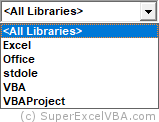
- Excel – This is a collection of classes available in Excel, allowing you to work with worksheets objects E.g. workbooks, spreadsheets, ranges, etc…
- Office – It is a generic class collection for all Office suite applications, allowing you to work with Office objects in general E.g. command bar, help, etc…
- stdole – It is the standard collection of the OLE class, it allows exchange of information between applications
- VBA – It is the class collection that allows functions to be used E.g. MsgBox, InputBox, string functions, etc…
- VBAProject – It is the local collection for the active workbook, (E.g. spreadsheets, users, etc…)
Class: is what defines the structure of a given object (E.g. for class Range we have objects like Range(«A1»), Range(«C2:B5»), and so on).
Enabling Libraries
To access, enable and disable libraries in VBA:
- In Excel, open the VBE (
+
)
- On the Menu Bar, click Tools
- Select References… (the References – VBAProject dialog box will be displayed)
- Select the desired libraries
- Click OK
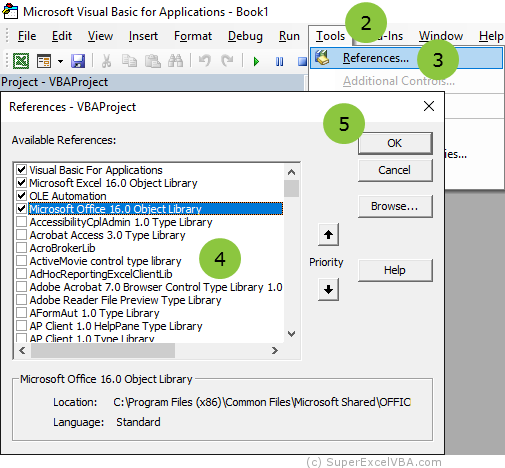
To add a library that is not in the list, use the 
Enabling additional libraries allows you to develop codes that communicate with other applications and processes. E.g. Word, Outlook, DAO (Data Access Objects), ADOdb (Active Data Objects database), etc…
When we refer to a library in the code but forget to enable it, the following error message is displayed:
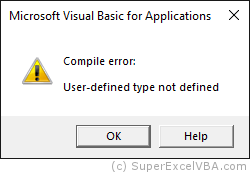
Object Browser
The Object Browser allows you to view the list of all the different objects, methods, and properties of the enabled libraries.
To search the libraries:
- Click on the Object Browser icon on the toolbar (
)
- Select the library you want to view on the dropdown menu
- Navigate the library
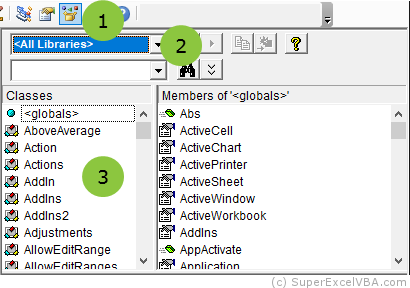
When in doubt, the Microsoft Help button (
VBA Early Binding vs Late Binding
You can use structures from a library without enabling it. This procedure is called Late Binding.
Dim OutApp As Object
Set OutApp = CreateObject("Outlook.Application")
Usually for the Late Binding a variable is declared as an object and later associated with CreateObject.
When we enable a library to access its structures we are performing what is called Early Binding.
Dim OutApp As New Outlook.Application
In the example case the Outlook library was enabled (
Early & Late Binding Differences
Early: From the point of view of code development and performance time, Early Binding is more suitable because it allows you to use Excel intellisense (

Late: Regarding compatibility errors, mainly due to the use of different versions of Excel (which changes the version of the libraries), Late Binding is more indicated.
Intellisense: is an aid, mainly to autocomplete the code, with useful information (

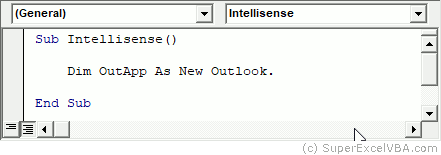
So, to gain practice with the libraries, try to write the code with Early Binding and later change it into Late Binding.
SuperExcelVBA.com is learning website. Examples might be simplified to improve reading and basic understanding. Tutorials, references, and examples are constantly reviewed to avoid errors, but we cannot warrant full correctness of all content. All Rights Reserved.
Excel ® is a registered trademark of the Microsoft Corporation.
© 2023 SuperExcelVBA | ABOUT
Name already in use
A tag already exists with the provided branch name. Many Git commands accept both tag and branch names, so creating this branch may cause unexpected behavior. Are you sure you want to create this branch?
1
branch
0
tags
Code
-
Use Git or checkout with SVN using the web URL.
-
Open with GitHub Desktop
-
Download ZIP
Latest commit
Files
Permalink
Failed to load latest commit information.
Type
Name
Latest commit message
Commit time
Excel Macro VBA Library
This repository is created to build a library of reusable VBA / Macro modules and functions for Microsoft Excel.
Right click to import the bas file as a new code module in excel vba.
Included generic funtions and subroutines:
1) WorksheetExists
2) CopyRowAboveAndInsert
3) ProperX
'This is exactly like the PROPER function but works also in VBA
'It makes the first letter in the input string capital
4) Email_part
'Returns the selected part of an email adress
5) current_user
'gets the user id of the currently logged on active user
6) current_user_domain
'gets the user domain of the currently logged on active user
7) get_user_info
'this function queries active directory for information about a user and returns one value at a time
8) get_user_id_from_distinguishedname
'this function queries active directory for the user id of a user with a certain distinguished name
9) get_user_id_from_email
'This functions is for when the LDAP query returns the Dist name but we want the ID
10) ReturnNthPartOfString
'Splits a delimited string and returns the Nth part
11) RegisterDescriptionForUserDefinedFunction()
' This function is only needed to run once to register help text and category for a user defined function
12) Custom_GetLastRow
13) Custom_SetRowHeightSheet
'Adjust row height for the entire sheet.
14) Custom_CopyRenameSheet
' Sub routine to copy a source sheet to a new sheet and to rename the new sheet.
15) Custom_NewRenameSheet
' Sub routine to create a new sheet and to rename the new sheet.
16) Custom_CopyPasteColumn
' Sub routine to copy a column at position 'columnReferenceNumber' and insert it at position 'pastePositionReference'.
17) Custom_InsertRenameColumn
' Sub routine to insert a new column at column position 'targetColumnReference' of the sheet 'targetSheet', set width as 'targetColumnWidth' and set name as 'targetColumnName'.
18) Custom_AddComment
' Add a comment to a cell.
19) Custom_RearrangeColumns
' Sub Routine to re-arrange columns from one sheet to another.
' A continuous column sequencing and definitions of order of rearrangement in the 'formatReferenceSheetName' is expected for this sub routine to work properly.
' Refer to "FR_1" sheet within the excel file "Excel_Reference_Sheet.xlsx" in the GitHub repository "excel-macro-vba-library".
20) Custom_EnterFormulaAndFillDown
' This sub routine enters a formula text 'formulaText' in a column's first cell (defined by 'targetSheet', 'columnReference' and 'rowOffset').
'The formula will be populated down to 'lastRow'. Furthermore, the function will replace the cells involved with their values and remove the formula definitions after the fill down has been completed.
21) Custom_ConvertNumberSavedAsText
' Sub routine to convert number stored as text to number.
22) Custom_DeleteColumn
' Delete the 'targetColumn' in 'targetSheet'.
23) Custom_CreatePivotTable
' Sub routine to create and design a Pivot Table as per definition in the Reference sheet formatReferenceSheet.
' Refer to "PR_1" and "PR_2" sheet within the excel file "Excel_Reference_Sheet.xlsx" in the GitHub repository "excel-macro-vba-library".
24) Custom_PivotTableAddField
' Create a Page Field (Report Filter) in the pivot table 'pivotTableName' in sheet 'pivotTableTargetSheet'.
25) Custom_PivotTableAddDataField
' Create a DataField in the pivot table 'pivotTableName' in sheet 'pivotTableTargetSheet', with name as 'dataFieldName' and with format 'dataFieldFormat'.
26) Custom_SetColumnNumberFormat
' Set the number format of a particular Column.
27) Custom_SortSheetByColumn
' Sort the entire sheet 'targetSheet' by the 'key1ColumnReference' in the order indicated by 'order1Reference'
28) Custom_RemoveDuplicates
' Remove all rows where the Column referred by 'indexColumnReference' has duplicate values.
29) Custom_FreezeView
' Freeze the view of the targetSheet. The Split will be made at columnSplitLength and rowSplitLength.
30) Custom_DeleteSheet
' Delete targetSheet.
31) Custom_ColorRange
' Enter color into the range.
32) Custom_HideSheet(targetSheet As Worksheet)
' Hide Sheet.
33) Custom_ColumnFilter
' Enable filter on a column of the targetSheet. Filter for string value criteriaString.
34) Custom_ReleaseFilter
' Remove all filters from the targetSheet.
35) Custom_DeleteVisibleRows
' Delete all Visible Rows in the targetSheet. This should be used after filtering the current sheet for the information you would want to have deleted.
36) Custom_SetColumnWidthSheet
' Adjust column width for the entire sheet.
37) Custom_InsertRenameColumn
AutoMacro
Ready-to-use VBA Code
See Pricing
What is AutoMacro?
AutoMacro is an add-in for VBA that installs directly into the Visual Basic Editor. It comes loaded with code generators, an extensive code library, the ability to create your own code library, and many other time-saving tools and utilities that add much needed functionality to the outdated VBA Editor.
AutoMacro does not need to be installed on a computer for the generated code to run. Once the code is generated, anyone can use it!
Code Builders
- Generate VBA code from scratch
- Visual interfaces
Learn More
Code Library
- Hundreds of ready-to-use code examples
- Save your own code
Keep Reading…
Coding Tools
- Tools for Formatting and Navigating
- Excel Model Debugger & More
Learn More
VBA Code Library
AutoMacro’s code library contains hundreds of commonly used code fragments for Excel, Access, Outlook, Word, and PowerPoint. As well as the ability to add your own code to the library.
Simply select the code from AutoMacro’s menu and it will be inserted directly into your module.
Compatible with
Loops Code Library
Loops and If statements are essential components of VBA programming . With the Loop Code Generator you can generate conditional loops with a few simple clicks.
Simply select the object (ex. rows) then the action (ex. delete) and last the criteria (ex. blank rows).
You can add additional actions or criteria and «match» the actions to the criteria, allowing you to perform different actions based on which criteria is met.
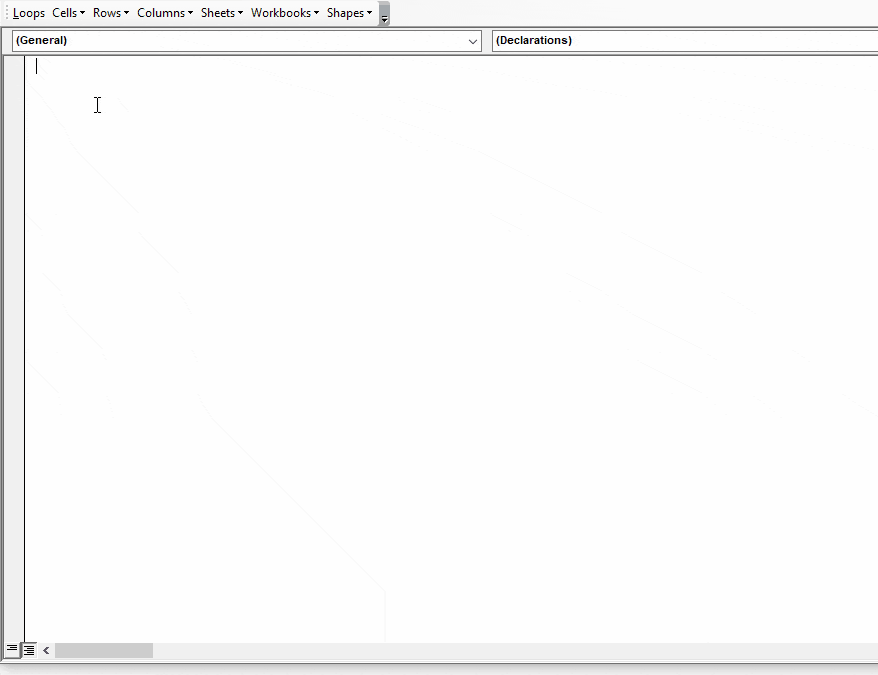
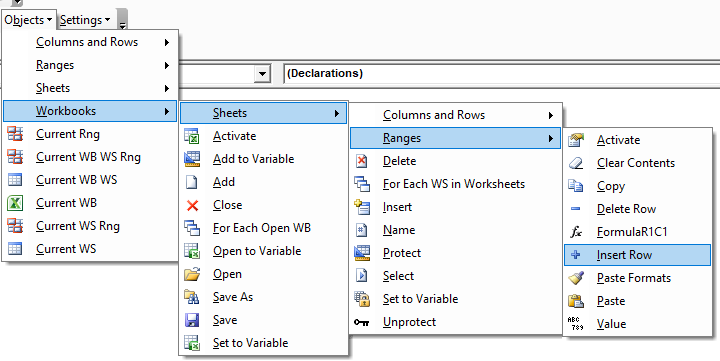
Object Code Library
Easily manipulate objects like Ranges, Columns, Rows, Sheets, and Workbooks. Great for Beginners or for editing code from the loop code generator.
Learn More
Functions and Procedures
Professionally developed functions and procedures a mouse-click away.
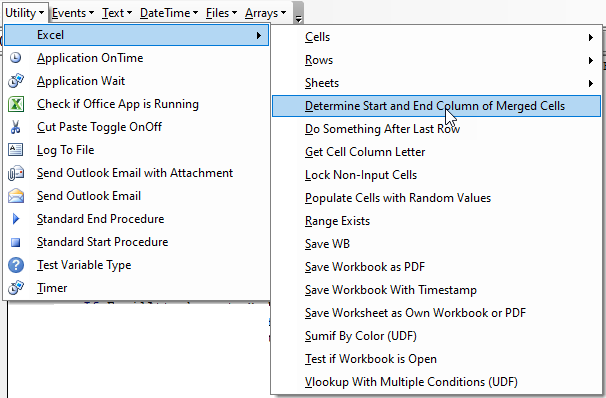
Code for Access, Outlook, Word, and PowerPoint
In addition to Excel, AutoMacro has code examples for Access, Outlook, Word, and PowerPoint.




Custom Code Library
Create your own VBA Code Library. Organize code into folders and access all code via keyboard shortcuts.
Share custom code folders with co-workers.
Join the Thousands of Professionals Who Use AutoMacro
«I use it almost every day. A great tool for getting things done, but also a great tool for learning how to do things! This is one purchase this year I have no regrets about.»
Galen — USA
4.7 Average Rating!
See Pricing
Other AutoMacro Features
Code Generators
Code Generators build code from scratch via visual interfaces.
No coding knowledge required!
Learn More
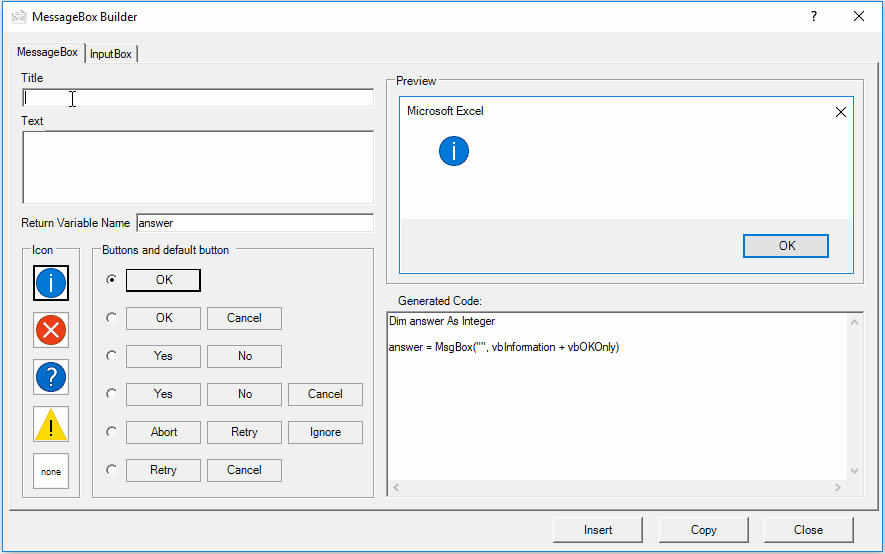
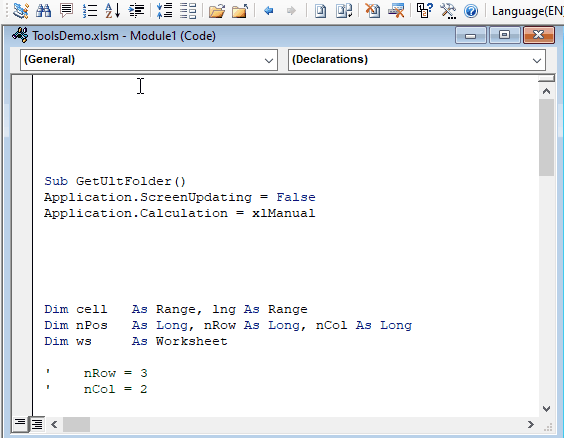
Coding Tools
VBA Coding tools to improve the out of date Visual Basic Editor.
Speed up your workflow with tools to navigate, debug, format and more.
Learn More
Beginner
1 User — 1 PC
- Interactive VBA Tutorial
- 100+ ready-to-use code examples
- Procedure, Loops, & Copy Paste Builders
- All other code generators
- Coding tools
- Create your own code library
- Transfer Activations to other PCs
- Access to new features & updates
One-time fee
Click for Alternative Payment Options

Upgrade Anytime!
Developer
1 User — 3 PCs
- Interactive VBA Tutorial
- Hundreds of ready-to-use code examples
- Procedure, Loops, & Copy Paste Builders
- All other code generators
- Coding tools
- Create your own code library
- Transfer Activations to other PCs
- Access to new features & updates
One-time fee
Click for Alternative Payment Options

Upgrade Anytime!
Developer+
1 User — 3 Transferable PCs & Updates
- Interactive VBA Tutorial
- Hundreds of ready-to-use code examples
- Procedure, Loops, & Copy Paste Builders
- All other code generators
- Coding tools
- Create your own code library
- Transfer activations to other PCs
- Access to new features & updates
One-time fee + $20 Annual
Click for Alternative Payment Options

AutoMacro has been used by employees of these organizations. These organizations do not endorse, approve, sponsor, or otherwise have any affiliation with this website, Spreadsheet Boot Camp LLC, or ToolFive Software LLC.
FAQ and Other Information
What is your refund policy?
We have a 30-day, no-questions-asked, 100% money-back guarantee. If you’re unsatisfied for any reason, let us know and we will refund your order!
Can I try AutoMacro before I buy?
Can I install AutoMacro on my Work Computer?
Yes! AutoMacro works in many corporate environments. It was designed to be as unobtrusive as possible and should install without the need for «admin privileges».
Will AutoMacro work on my system?
AutoMacro is compatible with all versions of Microsoft Office for PCs.
32-bit or 64-bit
Office 2003, 2007, 2010, 2013, 2016, 2019, Office 365, etc.
All Versions of Windows
Surface Pro
AutoMacro is not compatible with Mac operating systems. However, some Mac users running Windows OS are able to use AutoMacro.
If you have doubts, please try the download link above to check.
AutoMacro is not compatible with Citrix environments.
Can I deduct this purchase on my taxes?
See this page from the IRS on Employee Business Expenses.
Can I use on more than one computer?
The Beginner version entitles you to a single-use license code valid for 1 computer. The Developer version is valid for 3 computers. The Developer+ allows you to transfer activations between PCs, so that AutoMacro can be activated on any 3 PCs at one time.
Does AutoMacro work with PowerPoint, Word, or Access?
Yes! AutoMacro functions in any program with the Visual Basic Editor.
Specific code examples were developed for Excel, Access, Outlook, Word, and PowerPoint.
Visit AutoMacro’s FAQ Page
Join the Thousands of Professionals Who Use AutoMacro
«Great product, haven’t stopped using it since I purchased it. It doesn’t just write your code, it teaches as you go!»
Tony D — United Kingdom
4.7 Average Rating!
See Pricing
Steve Rynearson:
Creator of AutoMacro
Over the years, I’ve spent countless hours searching online for example code and adapting that code to my needs.
I often found myself clicking the same links and copying the same code. I thought there has to be a better way!
AutoMacro eliminates much of this need to search online for code. Instead simply use the menus to select pre-built code or use the builders to generate code for your exact needs.
Additionally, the coding tools will save you time and help you develop more professional looking code.
For anyone coding VBA, AutoMacro is a life-saver. You’ll code much faster, develop more professional code, and learn VBA much faster (if you’re not already an expert).
VBA Libraries
Libraries are used to access functionality outside of what VBA can do on its own. There are a number of VBA libraries provided by the Windows operating system, Office applications, and other software installed by the user. Libraries are often used to control a specific application or access classes which serve specific purposes. Libraries can be used to write VBA programs that utilize multiple applications, access the user’s file system, manipulate text files and databases, get information from the internet, and more.
Set Library References
Setting a reference to a library allows a VBA project to access the members of the library directly. Setting a reference allows the VBA compiler and the Visual Basic Editor to see the members of a library. Setting a reference allows for early-binding of object variables, enables intellisense, and makes the library visible in the Object Browser. To set a reference to a library navigate to Tools → References in the Visual Basic Editor and check the library and click Ok. Members of a library can be accessed without a reference by using late-binding (declaring an object variable with the generic Object type and using the CreateObject function with the class’s ProgID). Early-binding vs late-binding is discussed in the Objects section.
Fully Qualified Identifiers
When using libraries, be sure to use the fully qualified names for classes, variables, and procedures to avoid naming collisions. There are times when a library contains an identifier that is the same as another identifier in VBA or another library. If the name is not fully qualified, VBA will not know which identifier is being referred to and errors can occur. To fully qualify an identifier’s name include the library of origin.
Public Sub Example()
'References set to Excel object library and Word object library
Dim ExcelApp As Excel.Application
Dim WordApp As Word.Application
Set ExcelApp = Excel.Application
Set WordApp = Word.Application
End SubExploring Libraries
To explore the contents of a library in detail set a reference to the library and use the Object Browser to view the library’s members.
Search and Browse Specific Libraries
Specific libraries can be browsed and searched by selecting the library from the library drop-down.
View Class Members
Select an item in the Classes section and view its members in the Members section.
Search
Use the search bar to search for specific text related to a class or member. Select an item in the Search Results to view its members in the members section.
Important Libraries
There are a number of important libraries which are very commonly used and are often necessary for accomplishing tasks in VBA.
| Name: | Scripting |
|---|---|
| Description: | Microsoft Scripting Runtime |
| FullPath: | C:WindowsSystem32scrrun.dll |
| GUID: | {420B2830-E718-11CF-893D-00A0C9054228} |
| Use Cases: | File System, Text Files, Dictionary Class |
| Name: | ADODB |
|---|---|
| Description: | Microsoft ActiveX Data Objects 6.1 Library |
| FullPath: | C:Program FilesCommon FilesSystemadomsado15.dll |
| GUID: | {B691E011-1797-432E-907A-4D8C69339129} |
| Use Cases: | Databases, Text Files |
| Name: | MSHTML |
|---|---|
| Description: | Microsoft HTML Object Library |
| FullPath: | C:WindowsSystem32mshtml.tlb |
| GUID: | {3050F1C5-98B5-11CF-BB82-00AA00BDCE0B} |
| Use Cases: | HTML, DOM |
| Name: | SHDocVw |
|---|---|
| Description: | Microsoft Internet Controls |
| FullPath: | C:WindowsSystem32ieframe.dll |
| GUID: | {EAB22AC0-30C1-11CF-A7EB-0000C05BAE0B} |
| Use Cases: | IE Automation |
| Name: | WinHttp |
|---|---|
| Description: | Microsoft WinHTTP Services, version 5.1 |
| FullPath: | C:Windowssystem32winhttpcom.dll |
| GUID: | {662901FC-6951-4854-9EB2-D9A2570F2B2E} |
| Use Cases: | HTTP Requests |
| Name: | MSXML2 |
|---|---|
| Description: | Microsoft XML, v3.0 | v6.0 |
| FullPath: | C:WindowsSystem32msxml3.dll | C:WindowsSystem32msxml6.dll |
| GUID: | {F5078F18-C551-11D3-89B9-0000F81FE221} |
| Use Cases: | XML, HTTP Requests |
| Name: | Shell32 |
|---|---|
| Description: | Microsoft Shell Controls And Automation |
| FullPath: | C:WindowsSysWOW64shell32.dll |
| GUID: | {50A7E9B0-70EF-11D1-B75A-00A0C90564FE} |
| Use Cases: | Shell, Zip Files, File System |
| Name: | IWshRuntimeLibrary |
|---|---|
| Description: | Windows Script Host Object Model |
| FullPath: | C:WindowsSystem32wshom.ocx |
| GUID: | {F935DC20-1CF0-11D0-ADB9-00C04FD58A0B} |
| Use Cases: | Shell, Shortcuts, File System, Network, Registry |
| Name: | VBScript_RegExp_55 |
|---|---|
| Description: | Microsoft VBScript Regular Expressions 5.5 |
| FullPath: | C:WindowsSystem32vbscript.dll3 |
| GUID: | {3F4DACA7-160D-11D2-A8E9-00104B365C9F} |
| Use Cases: | Regular Expressions |
| Name: | VBIDE |
|---|---|
| Description: | Microsoft Visual Basic for Applications Extensibility 5.3 |
| FullPath: | C:Program Files (x86)Common FilesMicrosoft SharedVBAVBA6VBE6EXT.OLB |
| GUID: | {0002E157-0000-0000-C000-000000000046} |
| Use Cases: | Visual Basic Editor, Project References |
| Name: | mscorlib |
|---|---|
| Description: | mscorlib.dll |
| FullPath: | C:WindowsMicrosoft.NETFramework64v4.0.30319mscorlib.tlb |
| GUID: | {BED7F4EA-1A96-11D2-8F08-00A0C9A6186D} |
| Use Cases: | ArrayList |
Microsoft Office Applications
To work with more than one Office application in a single VBA program it is helpful to set references to all Office applications being used.
| Name: | Access |
|---|---|
| Description: | Microsoft Access 16.0 Object Library |
| FullPath | C:Program FilesMicrosoft OfficerootOffice16MSACC.OLB |
| GUID: | {4AFFC9A0-5F99-101B-AF4E-00AA003F0F07} |
| Name: | Excel |
|---|---|
| Description: | Microsoft Excel 16.0 Object Library |
| FullPath | C:Program FilesMicrosoft OfficerootOffice16EXCEL.EXE |
| GUID: | {00020813-0000-0000-C000-000000000046} |
| Name: | Outlook |
|---|---|
| Description: | Microsoft Outlook 16.0 Object Library |
| FullPath | C:Program FilesMicrosoft OfficerootOffice16MSOUTL.OLB |
| GUID: | {00062FFF-0000-0000-C000-000000000046} |
| Name: | PowerPoint |
|---|---|
| Description: | Microsoft PowerPoint 16.0 Object Library |
| FullPath | C:Program FilesMicrosoft OfficerootOffice16MSPPT.OLB |
| GUID: | {91493440-5A91-11CF-8700-00AA0060263B} |
| Name: | Publisher |
|---|---|
| Description: | Microsoft Publisher 16.0 Object Library |
| FullPath | C:Program FilesMicrosoft OfficerootOffice16MSPUB.TLB |
| GUID: | {0002123C-0000-0000-C000-000000000046} |
| Name: | Word |
|---|---|
| Description: | Microsoft Word 16.0 Object Library |
| FullPath | C:Program FilesMicrosoft OfficerootOffice16MSWORD.OLB |
| GUID: | {00020905-0000-0000-C000-000000000046} |
| Name: | Visio |
|---|---|
| Description: | Microsoft Visio 16.0 Type Library |
| FullPath | C:Program FilesMicrosoft OfficerootOffice16VISLIB.DLL |
| GUID: | {00021A98-0000-0000-C000-000000000046} |
Adobe Acrobat
The Adobe Acrobat Library can be used to automate the Adobe Acrobat application and work with PDF files. Adobe Acrobat must be purchased from Adobe and installed in order for the VBA libraries to be available.
| Name: | Acrobat |
|---|---|
| Description: | Adobe Acrobat 10.0 Type Library |
| FullPath: | C:Program Files (x86)AdobeAcrobat 2017Acrobatacrobat.tlb |
| GUID: | {E64169B3-3592-47D2-816E-602C5C13F328} |
| Name: | AFORMAUTLib |
|---|---|
| Description: | AFormAut 1.0 Type Library |
| FullPath: | C:Program Files (x86)AdobeAcrobat Reader DCReaderplug_insAcroForm.api |
| GUID: | {7CD06992-50AA-11D1-B8F0-00A0C9259304} |
Micro Focus Reflection
The Micro Focus Reflection libraries can be used to automate tasks in the Micro Focus Reflection application. Micro Focus Reflection Desktop 16.1 must be purchased and installed in order for the libraries to be available.
| Name: | Attachmate_Reflection_Objects |
|---|---|
| Description: | C:Program Files (x86)Micro FocusReflectionAttachmate.Reflection.Objects.tlb |
| GUID: | {6857A7F4-4CDE-43F2-A7B1-CB18BA8AA35F} |
| Name: | Attachmate_Reflection_Objects_Emulation_IbmHosts |
|---|---|
| Description: | C:Program Files (x86)Micro FocusReflectionAttachmate.Reflection.Objects.Emulation.IbmHosts.tlb |
| GUID: | {0D5D17DF-B511-4BE5-9CD0-10DE1385229D} |
| Name: | Attachmate_Reflection_Objects_Emulation_OpenSystems |
|---|---|
| Description: | C:Program Files (x86)Micro FocusReflectionAttachmate.Reflection.Objects.Emulation.OpenSystems.tlb |
| GUID: | {3BA4C5BF-F24A-4BE4-8BAB-8BD78C2FABDE} |
| Name: | Attachmate_Reflection_Objects_Framework |
|---|---|
| Description: | C:Program Files (x86)Micro FocusReflectionAttachmate.Reflection.Objects.Framework.tlb |
| GUID: | {88EC0C50-0C86-4679-B27D-63B2FCF1C6F4} |
Programmatically Work With Project References
To programmatically work with project references use the Microsoft Visual Basic for Applications Extensibility 5.3 Library (VBIDE).
'In Immediate Window:
?SetProjectReferenceByFilePath("C:WindowsSystem32scrrun.dll")
PrintProjectReferences ThisWorkbook.VBProjectOption Explicit
Public Sub SetProjectReferenceByFilePath(FilePath As String)
'Sets Project Reference
Dim VBProj As Object 'VBIDE.VBProject
Dim Refs As Object 'VBIDE.References
Dim Ref As Object 'VBIDE.Reference
Dim RefFound As Boolean
Set VBProj = ThisWorkbook.VBProject
Set Refs = VBProj.References
For Each Ref In Refs
If Ref.FullPath = FilePath Then
RefFound = True
Exit For
End If
Next Ref
If Not RefFound Then
VBProj.References.AddFromFile FilePath
End If
End Sub
Public Sub PrintProjectReferences(Proj As Object)
'Proj As VBIDE.VBProject
Dim Ref As Object 'VBIDE.Reference
For Each Ref In Proj.References
With Ref
Debug.Print "'''''''''''''''''''''''''''''''''''''''''''''''''"
Debug.Print "Name: " & .Name
Debug.Print "Major Version: " & .Major
Debug.Print "Minor Version: " & .Minor
Debug.Print "Description: " & .Description
Debug.Print "FullPath: " & .FullPath
Debug.Print "GUID: " & .GUID
Debug.Print "Builtin: " & .BuiltIn
Debug.Print "Type: " & .Type
Debug.Print "'''''''''''''''''''''''''''''''''''''''''''''''''"
End With
Next Ref
End Sub


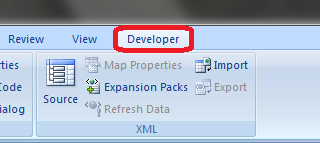











 +
+ )
) )
)




